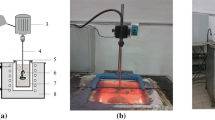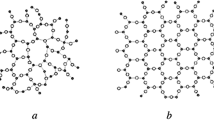Abstract
A survey of occurring methods of silumin production is presented. The possibility of fabricating casting alloys using amorphous microsilica is shown. Various methods of introducing silicon dioxide particles into the aluminum melt are studied and approved, notably, in the form of pelleted “aluminum powder–SiO2” master alloys, by admixing particles into the melt at the liquidus temperature and by introducing SiO2 into the melt jointly with the argon flow. Calculations of the formation enthalpies and variations in the Gibbs energy of the reduction of silicon from its oxide by aluminum are performed. The thermodynamic probability of formation of silumins using amorphous microsilica is shown based on these calculations. The influence of alloying additives and impurities on the process flow of silicon reduction is determined. The possibility of using magnesium as the surfactant additive, making it possible to remove oxygen from the surface of dispersed particles and reduce silicon from its oxide, is revealed. It is determined that the fabrication method of casting silumins by introducing amorphous silica preliminarily heated to 300°C into the aluminum melt (t = 900°C) jointly with the argon flow (with the subsequent intense stirring) jointly with the argon flow (with subsequent intense stirring) possesses the largest efficiency, because it makes it possible to fabricate aluminum–silicon alloys with a Si content higher than 6 wt % and microstructure corresponding to hypoeutectic casting silumins. The industrial implementation of the proposed method will make it possible to increase the efficiency of the occurring production process of silumins due to the economy of resources spent on purchasing commercial crystalline silicon. Moreover, this technology will promote lowering the environmental load to the surrounding medium due to the reduction of volumes and subsequent elimination of sludge fields, which are landfills for storing dust from gas purification systems of silicon production that contain up to 95 wt % amorphous microsilica.







Similar content being viewed by others
REFERENCES
Steent, A.H. and Hellawell, A., Structure and properties of aluminium–silicon eutectic alloys, Acta Metall., 1972, vol. 20, pp. 363–370.
Pietrowski, S., Characteristic features of silumin alloys crystallization, Mater. Des., 1997, vol. 18, nos. 4–6, pp. 373–383.
Bo Jiang, Zesheng Ji, Maoliang Hu, Hongyu Xu, and Song Xu, A novel modifier on eutectic Si and mechanical properties of Al–Si alloy, Mater. Lett., 2019, vol. 239, pp. 13–16.
Zhi-kai Zheng, Yong-jian Ji, Wei-min Mao, Rui Yue, and Zhi-yong Liu, Influence of rheo-diecasting processing parameters on microstructure and mechanical properties of hypereutectic Al–30% Si alloy, Trans. Nonferr. Met. Soc. China, 2017, vol. 27, pp. 1264–1272.
Belov, N.A., Fazovyi sostav alyuminievykh splavov (Phase Composition of Aluminum Alloys), Moscow: MISiS, 2009.
Belyaev, A.I., Bochvar, O.S., and Bunov, N.N., Alyuminievye splavy. Metallovedenie alyuminiya i ego splavov (Aluminum alloys. Metallurgical Science of Aluminum and Its Alloys), Moscow: Metallurgiya, 1983.
Al’tman, M.B., Lebedev, A.A., and Chukhrov, M.V., Plavlenie i lit’e alyuminievykh splavov: Spravochnoe izdanie (Melting and Casting of Aluminum Alloys: Reference Book), Moscow: Metallurgiya, 1983, 2nd ed.
Popov, S.I., Metallurgiya kremniya v trekhfaznykh rudnotermicheskikh pechakh (Silicon Metallurgy in Three-Phase Ore-Thermal Furnaces), Irkutsk: ZAO “Kremnii”, 2004.
Cao, W., Chen, S.-L., Zhang, F., Wu, K., Yang, Y., Chang, Y.A., Schmid-Fetzer, R., and Oates, W.A., PANDAT software with PanEngine, PanOptimizer and PanPrecipitation for multi-component phase diagram calculation and materials property simulation, Caplhad, 2009, vol. 33, no. 2, pp. 323–342.
Bakker, H., Enthalpies in Alloys. Miedema’s Semi-Empirical Model, Switzerland, Zurich: Trans Tech., 1998.
Kuz’min, M.P. and Begunov, A.I., Approximate calculations of thermodynamic characteristics of intermetallic connections based on aluminum, Vestn. IRGTU, 2013, no. 1 (72), pp. 98–102.
Kondrat’ev, V.V., Karlina, A.I., Nemarov, A.A., and Ivanov, N.N., Results of theoretical and practical researches of flotation of nanodimensional siliceous structures, Zh. SFU. Tekh. Tekhnol., 2016, vol. 9, no. 5, pp. 657–670.
Rafal’skii, I.V., Fabrication of foundry composite materials from aluminum alloys in a heterophase state with disperse fillers, Lit’e Metall., 2011, no. 3, pp. 26–31.
Arabei, A.V., Rafal’skii, I.V., and Nemenenok, B.M., Synthesis of alloys of the Al–Si system from the aluminum matrix compositions formed using aluminum waste and quartz sand, Met. Lit’e Ukr., 2013, no. 4 (239), pp. 3–7.
Gavrilin, I.V., Kechin, V.A., and Koltyshev, V.I., Poluchenie liteinykh siluminov s ispol’zovaniem pylevidnogo kremniya i metallootkhodov (Fabrication of Casting Silumins Using Dusty Silicon and Metal Waste), Vladimir: Vladimir. Gos. Univ., 2003.
Gavrilin, I.V., Kechin, V.A., and Koltyshev, V.I., Application of silicon-containing materials for fabricating aluminum–silicon alloys, Teor. Technol. Litein. Splav., 1999, no. 1, pp. 10–12.
Kuz’min, M.P., Kondrat’ev, V.V., Larionov, L.M., Kuz’mina, M.Y., and Ivanchik, N.N., Possibility of preparing alloys of the Al–Si system using amorphous microsilica, Metallurgist, 2017, vol. 61, pp. 86–91.
Sree Manu, K.M., Sreeraj, K., Rajan, T.P.D., Shereema, R.M., Pai, B.C., and Arun, B., Structure and properties of modified compocast microsilica reinforced aluminum matrix composite, Mater. Des., 2015, vol. 88, pp. 294–301.
Pai, B.C., Geetha Ramani, Pillai, R.M., and Satyanarayana, KG., Role of magnesium in cast aluminium alloy matrix composites, J. Mater. Sci., 1995, vol. 30, pp. 1903–1911.
Gowri Shankar, Jayashree, M.C., Kini, P.K., Achutha, U., and Sharma, S.S., Effect of silicon oxide (SiO2) reinforced particles on ageing behavior of Al–2024 alloy, Int. J. Mech. Eng. Technol., 2014, vol. 5, no. 9, pp. 15–21.
Robie, A.R. and Hemingway, B.S., Thermodynamic Properties of Minerals and Related Substances at 298.15 K and 1 bar (105 Pascals) Pressure and at Higher Temperatures, Washington: US Government Printing Office, 1995.
Ailer, R., Khimiya kremnezema (Chemistry of Silica), Moscow: Mir, 1982.
Ryabin, V.A., Termodinamicheskie svoistva veshchestv: Spravochnik (Thermodynamic Properties of Substances: Reference Book), Leningrad: Khimiya, 1977.
Rafal'skii, I.V. and Arabei, A.V., The thermodynamic analysis of phase interaction reactions between components of foundry alloys prepared from aluminum matrix composites based on the Al–SiO2 system, Fundam. Probl. Sovrem. Materialoved., 2012, vol. 9, no. 3, pp. 375–378.
Bobkova, N.M., Fizicheskaya khimiya tugoplavkikh nemetallicheskikh i silikatnykh materialov (Physical Chemistry of Refractory Nonmetallic and Silicate Materials), Minsk: Vyshaya Shkola, 2007.
Kondratiev, V.V., Govorkov, A.S., Kolosov, A.D., Gorovoy, V.O., and Karlina, A.I., The development of a test stand for developing technological operation flotation and separation of MD2. The deposition of nanostructures MD1 produces nanostructures with desired properties, Int. J. Appl. Eng. Res., 2017, vol. 12, no. 22, pp. 12373–12377.
Zenkov, E.V. and Tsvik, L.B., Increasing the reliability the combined criteria of the static strength of a material of complexly loaded deformable structures, Mater. Phys. Mech., 2018, no. 40, pp. 124–132.
Kondratiev, V.V., Nebogin, S.A., Gorovoy, V.O., Sysoev, I.A., and Karlina, A.I., Description of the test stand for developing of technological operation of nano-dispersed dust preliminary coagulation, Int. J. Appl. Eng. Res., 2017, vol. 12, no. 22, pp. 12809–12813.
Zenkov, E.V. and Tsvik, L.B., Stress-strain state of prismatic samples with hollow chamfers, Russ. Eng. Res., 2013, vol. 33, no. 10, pp. 562–565.
Kondrat’ev, V.V., Ershov, V.A., Shakhrai, S.G., Ivanov, N.A., and Karlina, A.I., Formation and utilization of nanostructures based on carbon during primary aluminum production, Metallurgist, 2016, vol. 60, nos. 7–8, pp. 877–882.
Rafal’skii, I.V. and Nemenenok, B.M., Physicochemical interaction of components of the Al/SiO2 system in metallurgical synthesis processes of casting dispersion-hardened aluminum alloys, Lit’e Metall., 2017, no. 2 (87), pp. 31–39.
Author information
Authors and Affiliations
Corresponding authors
Ethics declarations
The authors claim that they have no conflict of interest.
Additional information
Translated by N. Korovin
About this article
Cite this article
Kuz’min, M.P., Larionov, L.M., Kondratiev, V.V. et al. Fabrication of Silumins Using Silicon Production Waste. Russ. J. Non-ferrous Metals 60, 483–491 (2019). https://doi.org/10.3103/S1067821219050122
Received:
Revised:
Accepted:
Published:
Issue Date:
DOI: https://doi.org/10.3103/S1067821219050122




